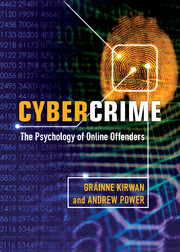Book contents
- Frontmatter
- Contents
- Detailed contents
- List of illustrations
- List of tables
- Preface
- 1 Psychology of cybercrime
- 2 Cybercrimes and cyberlaw
- 3 Hackers
- 4 Malware
- 5 Identity theft and fraud
- 6 Child predation and child pornography online
- 7 Cyberbullying and cyberstalking
- 8 Digital piracy and copyright infringement
- 9 Cyberterrorism
- 10 Crime in virtual worlds
- References
- Index
4 - Malware
Published online by Cambridge University Press: 05 July 2013
- Frontmatter
- Contents
- Detailed contents
- List of illustrations
- List of tables
- Preface
- 1 Psychology of cybercrime
- 2 Cybercrimes and cyberlaw
- 3 Hackers
- 4 Malware
- 5 Identity theft and fraud
- 6 Child predation and child pornography online
- 7 Cyberbullying and cyberstalking
- 8 Digital piracy and copyright infringement
- 9 Cyberterrorism
- 10 Crime in virtual worlds
- References
- Index
Summary
Case studies
‘Cookie monster’ was an early computer virus type program. This relatively benign virus would prevent the person from using the computer by requesting a ‘cookie’ at regular intervals. If the user typed in the word ‘cookie’, the message would disappear, only to reappear a while later requesting another treat. The ‘cookie monster’ virus was an irritation, but it spread slowly and was relatively benign as it did not damage the computer, nor steal data from the user.
More modern viruses can have considerably more serious consequences. An example of malware with much more serious potential is the Stuxnet worm, first detected in June 2010. In September of that year it was revealed that the worm had infected computers at Iran's first nuclear power station (BBC News Online, 2010). The Stuxnet worm specifically targets systems used to manage utilities such as water, oil rigs and power plants. It is a highly tailored worm, and is thought to be the first worm designed to target such facilities. Instead of using the internet to distribute itself it infects Windows via portable memory devices such as universal serial bus (USB) keys. Because of this it can target systems that are not connected to the internet for security reasons. Once infected, the worm can reprogram the software which gives instructions to industrial machinery, such as motors and coolers, telling them to turn on or off at given signals.
- Type
- Chapter
- Information
- CybercrimeThe Psychology of Online Offenders, pp. 79 - 102Publisher: Cambridge University PressPrint publication year: 2013



